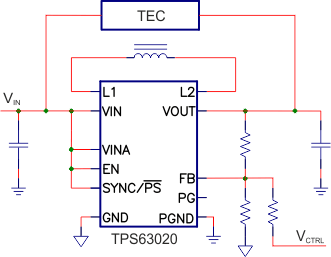SLVS916I July 2010 – October 2019 TPS63020 , TPS63021
PRODUCTION DATA.
- 1 Features
- 2 Applications
- 3 Description
- 4 Revision History
- 5 Pin Configuration and Functions
- 6 Specifications
- 7 Detailed Description
- 8 Application and Implementation
- 9 Power Supply Recommendations
- 10Layout
- 11Device and Documentation Support
- 12Mechanical, Packaging, and Orderable Information
Package Options
Mechanical Data (Package|Pins)
- DSJ|14
Thermal pad, mechanical data (Package|Pins)
- DSJ|14
Orderable Information
8.3.3 Low-Power TEC Driver
Controlling the operating temperature of electronic circuits helps attain the best system performance. For passive control, that is, when heat sinks is not giving the right performance, active cooling using a thermoelectric cooler (TEC) might be able to solve the thermal issue. Figure 30 shows an example driving such a TEC element with the TPS63020. Refer to the Low-power TEC Driver Application Report.
 Figure 30. Low-Power TEC Driver Schematic
Figure 30. Low-Power TEC Driver Schematic